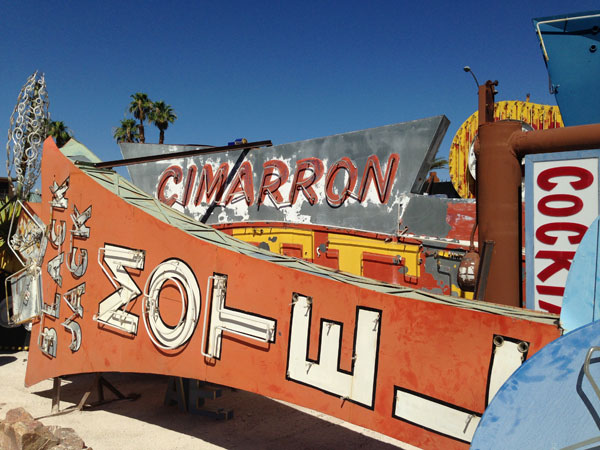Leaving Las Vegas a heritage

Roula Khalaf, Editor of the FT, selects her favourite stories in this weekly newsletter.
Vegas Vic is a 40-ft, neon-lit sign of a smiling cowboy with a glint in his eye, and a cocky wave at his permanent disposal. He currently stands in the middle of Las Vegas’s rapidly regenerating downtown area but he was born in an altogether different time. In the early 1950s, Vic was employed to advertise the louche charms of the Pioneer Club, one of the city’s most notable dens of pleasure-seeking.
His advocacy was not subtle. “Howdy, Podner!” he welcomed tourists, every 15 minutes of every day. During a stay in a nearby hotel in 1966, the thunderously voiced movie star Lee Marvin took exception to Vic’s salute, and asked that it be silenced. (What a conversation that must have been.) The cowboy became mute. In 1991, he stopped waving, too.
Vegas Vic also features in one of the most famous postcards of the heady postwar era in which he was created. In the foreground of a luridly coloured illustration, Vic is smiling, smoking, waving. The signs all around him promise delights: Jackpots! Liquor! Free Parking! But in the distance, a still more spectacular attraction catches the eye. Is it a mushroom? Is it a cloud? Why, it’s a mushroom cloud.
During the 1950s, Vegas was the “Up and Atom” city, the perfect vantage point from which to view the nuclear tests that took place in nearby Nye County. Vic has history, all right, and he wears his experience proudly. He is the only man in the world, other than Ronnie Wood, who still thinks it fetching to dangle a cigarette from his parched, and possibly radioactive, lips.
Vic and his neon buddies are a part of Vegas that the city’s pioneers never dreamt they would need to pay attention to: its heritage. The gambling paradise famously refuses to put clocks on its walls so that hapless visitors will more easily lose track of time, money and their senses.
It is earthed in the fleshy joys of the present, and aims relentlessly towards the future, devising ever more ingenious ways of entertaining the feckless part of the human spirit. But its past is catching up with it. Vegas is now old enough to have a history. And it needs to decide what that history is.
Vegas Vic is part of it. Many of the flashy signs that once shared the atomically charged skies with the cowboy are today assembled in the “boneyard” of the city’s refreshed Neon Museum, which offers tours of the spent bulbs that are the only remains of bygone glories.
It is an unmissable and strangely moving experience. Here is the sign for the New Frontier Hotel, where Elvis first played (and bombed) in Vegas; around the corner there is one for the Jackpot Motel, which should surely have held back some of the pot to help it survive the ravages of forthcoming years.
The museum does its best in the way of restoration but, to be perfectly honest, I wish it only limited success. The romance of decrepitude is keenly felt in the archaeological museums of southern Europe and the Middle East. But there is something yet more touching about seeing recent history falling apart before our eyes. It reminds us that everything moves fast these days, even decay.
Not far from the neon boneyard is the Mob Museum. Another part of Vegas’s history, the role of organised crime in its expansion, is treated here with something approaching a spirit of camp. “There are two sides to every story,” warns the cover of the programme, just in case you were leaning unequivocally towards the good guys.
You can shoot a tommy gun (sound effects only), sit in the courtroom that housed some of the most dramatic congressional hearings of the time, and see the original wall, rebuilt and splashed with blood, against which the St Valentine’s Day massacre took place.
I bow to no one in admiration of Vegas’s relentlessly innovative spirit. It is, along with Venice, the world’s most fantastical city, a towering testament to hyper-capitalism and a triumph of the hedonic impulse. But it needed to come to terms with its past. The Rat Pack shenanigans, the shady dealings of past investments: they cast a shadow over the city. The seeking out and presentation of its heritage has been a catharsis for it.
It’s easy to invent the future, given the drive, the imagination and the money. What can be much harder for a city is to define its past. That is where culture comes in. It is why each new megalopolis of the 21st century, whether it is in China, or South America or the Middle East, strives so hard to establish its cultural credentials. Tell a good story about your past, and you can move freely into your future. Wave your troubles away, and step into the unknown. You’ll always find a friend to welcome you, with a jaunty “Howdy, Podner!”
——————————————-
More columns at www.ft.com/aspden
Listen to a podcast of this column at www.ft.com/culturecast
Comments